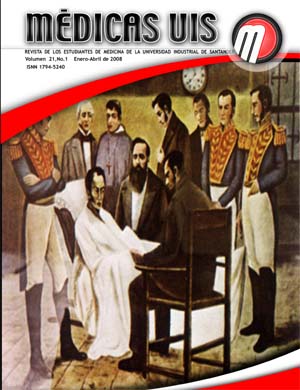Resumen
El transporte aeromédico se ha desarrollado vertiginosamente durante la segunda mitad del siglo pasado, gracias al avance en las tecnologías en materia de aviación y en equipo para la atención del paciente. Sin embargo, es una realidad la escasez de aeronaves dedicadas a este propósito, ya que la mayoría son charters o taxis aéreos adaptados, sin personal experto y sin el equipo adecuado. En el caso de Colombia no existe un servicio de helicóptero o avión ambulancia especializada. En este artículo se exponen las ventajas y las circunstancias especiales que rodean el transporte aeromédico, sin pretender ser una revisión extensa del tema.
Palabras clave: Transporte aéreo. Transporte pacientes. Transporte aeromédico.
Aeromedical transportation has been developed since the last half of the past century, thanks to the advances in avionics and medical equipment. However, it's a reality the lack of medical aircraft, the ones that exist are charters or air taxis, without healthcare professionals or without medical equipment. In the case of Colombia, there is no specialized ambulance helicopter o plains service. In this article advantages and special circumstances are exposed, without pretending to be an extensive review.
Keywords: Airway transportation. Patient transportation.Aeromedical transport.
Referencias
2.Collett H. The conference cometh. Hosp Aviation. 1999;9:5.
3.Cottrell JJ, Garrard G. Emergency transport by aeromedical blimp. BMJ. 1999;298:869-70. National Transportation Safety Board Emergency medical service helicopter operations. Washington, DC: National Transportation Safety Board. 2005. publication No. 14. Collett H. 1989 Accident review. J Air Med Transport. 1999;9:12.
4.Cottrell JJ, Garrard G. Emergency transport by aeromedical blimp. BMJ. 1989;298:869- 70.
5.Dunn JD. Legal aspects of transportation. Probl Crit Care. 1999;4:447-8.
6.Edge WE, Kanter RK, Walsh RF. Reduction of morbidity in interhospital transport by specialized pediatric staff. Critical Care Medicine. 1994;22:1186-91.
7.Fromm R, Cronin L. Issues in critical care transport. Probl Crit Care 1989; 3:439 - 46.
8.Fromm R, Duvall J. Medical aspects of flight for civilian aeromedical transport. Probl Crit Care. 1999;4:495-507.
9.Fromm R, Hoskins E, Gonin L, Pratt C, Spencer W, Roberts R. Bleeding complications following initiation of thrombolytic therapy for acute myocardial infarction: a comparison of helicopter-transported and non-transported patients. Ann Emerg Med. 1991;20:892-5.
10.Galipault JB. Angels of mercy must not fall. The Aviat Safety Monitor. J Air Med Transport. 1992;Jul:31.
11.Gray G. Respiratory Diseases. Aerospace Medicine. De hart Roy Lippincott. Third ed 2002. p. 323-9.
12.Guidelines Committee of the American College of Critical Care Medicine, Society of Critical Care Medicine, and American Association of Critical-Care Nurses Transfer Guidelines Task Force. Guidelines for the transfer of critically ill patients. Cricial Care Medicine. 2003;21(6):931-7.
13.Holt R. Otolaryngology in Aerospace Medicine. Aerospace Medicine. De Hart Roy Lippincott. Third ed. 2002. p. 420-5.
14.Kaplan L, Walsh D, Burney RE. Emergency aeromedical transport of patients with acute myocardial infarction. Ann Emerg Med. 1987;16:55-7.
15.KRUYER W. Clinical Aerospace. Cardiovascular Medicine. De hart Roy Lippincott. Third ed. 2002. p. 333-5.
16.Lam D. Wings of life and hope: a history of aeromedical evacuation. Probl Crit Care. 2000;4:477-94.
17.Low RB, Dunne MJ, Blumen IJ, Tagney G. Factors associated with the safety of EMS helicopters. Am J Emerg Med. 1991;9:103-6.
18.Peckler S, Rodgers R. Air versus ground transport for the trauma scene: optimal distance for helicopter utilization. J Air Med Transport. 1998;8:44.
19.Snow N, Hull G, Severns J. Physician presence on helicopter emergency service: necessary or desirable? Aviat Space Environ Med. 1986;57:1176-8.
20.Sookram S, Barker S, Kelly KD, Patton W, Neilson K, Rowe BH. Is body temperature maintained effectively during aeromedical transport? An interim analysis [abstract]. Canadian Journal of Emergency Medicine. 1999;1:A66.
